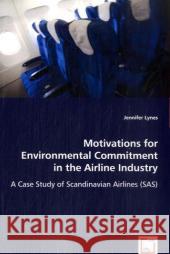Motivations for Environmental Commitment in the Airline Industry » książka
Motivations for Environmental Commitment in the Airline Industry
ISBN-13: 9783639020625 / Angielski / Miękka / 2008 / 256 str.
The airline industry is increasingly in the spotlight with regards to its impact on the environment. Given the various internal, external and cultural pressures facing airlines in their day-to-day operations, what motivates some airlines to be greener than others? This study examines the literature on the greening of corporations in the context of the airline industry and uses Scandinavian Airlines (SAS) as an in-depth case study that explores the airline's drivers for environmental commitment. Two key decisions that were made within SAS (one involving the purchase of a new aircraft fleet and the other the launch of a new inflight service concept) are used to demonstrate how environmental issues were taken into consideration in the airline's decision-making process. Although various studies have looked at aviation's impacts on the environment, this is one of the first studies to examine the internal management processes used to develop company policies in the airline industry.
The airline industry is increasingly in the spotlight with regards to its impact on the environment. Given the various internal, external and cultural pressures facing airlines in their day-to-day operations, what motivates some airlines to be greener than others? This study examines the literature on the greening of corporations in the context of the airline industry and uses Scandinavian Airlines (SAS) as an in-depth case study that explores the airlines drivers for environmental commitment. Two key decisions that were made within SAS (one involving the purchase of a new aircraft fleet and the other the launch of a new inflight service concept) are used to demonstrate how environmental issues were taken into consideration in the airlines decision-making process. Although various studies have looked at aviations impacts on the environment, this is one of the first studies to examine the internal management processes used to develop company policies in the airline industry.











